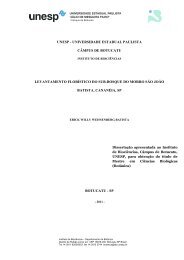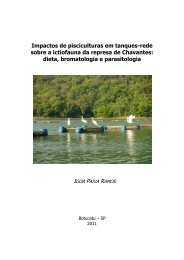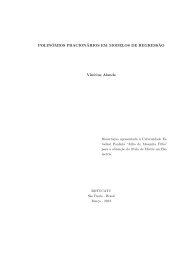Visualizar Tese - Instituto de Biociências - Unesp
Visualizar Tese - Instituto de Biociências - Unesp
Visualizar Tese - Instituto de Biociências - Unesp
You also want an ePaper? Increase the reach of your titles
YUMPU automatically turns print PDFs into web optimized ePapers that Google loves.
0,45<br />
0,40<br />
Freqüência relativa (%)<br />
0,35<br />
0,30<br />
0,25<br />
0,20<br />
0,15<br />
0,10<br />
0,05<br />
0,00<br />
Characiformes<br />
Siluriformes<br />
Perciformes<br />
Gymnotiformes<br />
Or<strong>de</strong>ns<br />
Characiformes Siluriformes Perciformes Gymnotiformes<br />
Fig.27: Freqüência relativa (%) das 72 espécies, por or<strong>de</strong>ns, <strong>de</strong>sembarcadas na al<strong>de</strong>ia <strong>de</strong> Buritama,<br />
no período <strong>de</strong> estudo.<br />
O número <strong>de</strong> espécies variou também <strong>de</strong> acordo com as famílias,<br />
estando representadas, na Tabela 2 e Figura 28.<br />
Nota-se que as famílias mais representativas foram, em or<strong>de</strong>m<br />
<strong>de</strong>crescente, a Characidae, com 15 espécies; Loricariidae, com 15 espécies;<br />
Anostomidae, com 10 espécies; Cichlidae, com 11 espécies; Pimelodidae, com 4<br />
espécies. Entretanto, as famílias restantes foram compostas por apenas uma ou<br />
duas espécies.
















